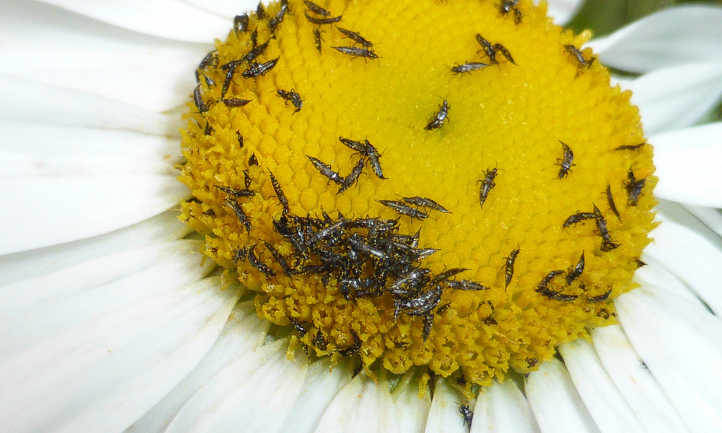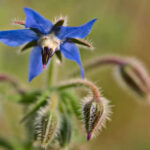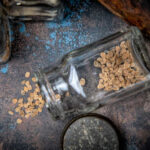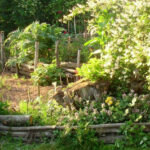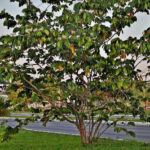Have you noticed the silvering of leaves in your garden recently? Was the silvery leaf sheen accompanied by discolored stippling? Well, you might have thrips, one of the most widespread insect pests out there.
While it may be discouraging to see tiny thrips or evidence of thrips feeding on plant tissue, there are ways to reduce the damage they’ve caused. There are also ways to control their spread in the garden. So if you see them, know that you’ve got this.
Let’s talk about thrips! We’ll discuss different kinds of thrips, and integrated pest management strategies for controlling thrips in your garden. Sometimes you’ll need to get rid of thrips and sometimes you won’t. Once you know how to handle them, you’ll have an advantage over pests and diseases.
Subscribe to the Epic Gardening Podcast on
Overview
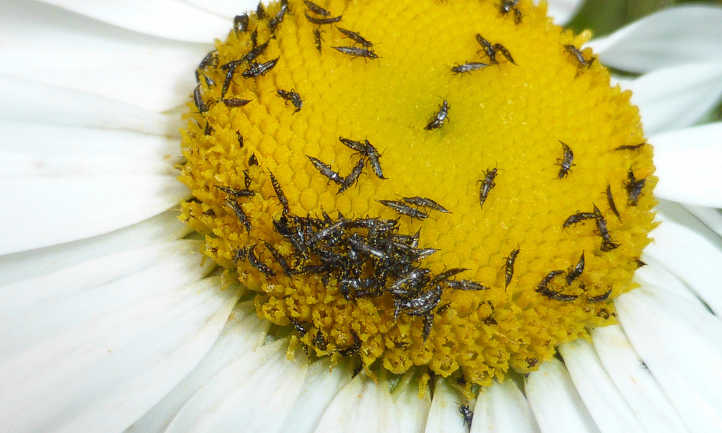
| Common Name(s) | Thrips, corn lice, thunderbugs, storm bugs, freckle bugs, thunderblights, harvest bugs, corn flies |
| Scientific Name(s) | Thousands of species in the order Thysanoptera |
| Family | Terebrantia, Tubulifera |
| Origin | Worldwide |
| Plants Affected | Most commercially-farmed crops, many ornamental plants, trees, etc. There are many different varieties that prefer particular plants, such as onions, tobacco, cannabis, rose, avocado, and citrus. |
| Common Remedies | Insecticidal soaps, neem oil, pyrethrin sprays, diatomaceous earth, predatorial insects (ladybugs, lacewings, Trichogramma wasps, minute pirate bugs, thrips predator mites), sticky traps. |
What Are Thrips?
Thrips are sucking insects in the Thysanoptera order that feed on flower petals, buds, and plant tissue. They’re long, slender insects that are rarely over an inch in length in their adult form. Thrips larvae are generally yellow or green. Adult versions of these tiny insects tend to be yellow, black, or brown. Certain varieties have either fringed wings or vestigial wings. While they may not be the best fliers, they have strength in numbers. The total species of thrips in the world lies somewhere between 4500 and 6000. Some thrips are detrimental and damage plants, many thrips species are beneficial and prey on pest species. Pest thrips can cause damage simply by feeding, or they can spread plant viruses and fungal spores.
Types Of Thrips

Here is a list of the most common thrips you may find in your garden or greenhouse. Use this to identify thrips species and determine what actions to take.
Avocado Thrips: Primarily found on avocados. Adults have three red spots on their heads and a pale yellow abdomen with brown lines separating segments. Their larvae are pale yellow. The damage they cause is scarring on avocado fruit in the form of scab-like brown patches or lines.
Bean Thrips: Found on green bean and other legume plants. Adults have a blackish body with white wing bands. Larvae are yellow to orangish. They cause brown, distorted leaf and seedling terminals on certain legumes. They also cause damage to bean pods.
Citrus Thrips: Commonly damaging to citrus trees and blueberries. Not damaging to other host plant species. Both adult thrips and larvae have a light orangish-yellow to white body. They cause scabby silvery scars on citrus fruit and warped blueberry leaves and shoots.
Cuban Laurel Thrips: Damaging to laurel fig or Indian laurel. Adult thrips have a blackish body and the larvae are yellow to white. They create galls, and rolled, podlike, dark, scarred terminals on laurels.
Greenhouse Thrips: Attack perennials with thick, broad leaves. Susceptible species include avocado, azalea, hypericum, laurel (English and Grecian), photinia, and rhododendron. Larvae are white to yellowish and adults have a black body with pale wings. On the aforementioned species, they cause bleached leaves with black excrement on the undersides and scabby fruit.
Melon Thrips: Feed on all kinds of vegetables, fruit trees, weeds, and several flowering plants such as carnation and chrysanthemum flowers. Larvae are yellow, and adults are orangeish brown. They provoke the yellowing, whitening, or browning of leaves. Affected foliage crinkles and dies.
Myoporum Thrips: Affects only mousehole tree and Creeping Boobialla ‘Pacificum’ (Myoporum laetum and M. pacificum). Pupae are orangish, and early nymphs are white to yellowish. Adults have a black body. They create galls at leaf terminals and swollen, curled, and distorted leaves.
Onion Thrips: These thrips consume vegetable crops of garlic, onion, and pepper. They are also hosted by many herbaceous ornamentals, where they aren’t damaging. Larvae are yellow to orangeish, and adults have a yellow to dark brown body. They cause distorted terminals and stippled and scarred petals, leaves, and other plant parts.
Toyon Thrips: Affects Christmas berry or toyon. Adults have a black body with pale wings, and larvae are yellow. They cause crinkled, undersized, sometimes blackened terminal leaves.
Western Flower Thrips: These seemingly indiscriminate thrips eat up herbaceous plants, impatiens and petunia, cucurbits, peppers, grapes, strawberries, woody plants like rose, and stone fruit. The larvae are yellow to orangish. Adults vary in color, but all have bristle-like hairs at the tip of the abdomen, which extends beyond the wingtips at rest.
Life Cycle of Thrips
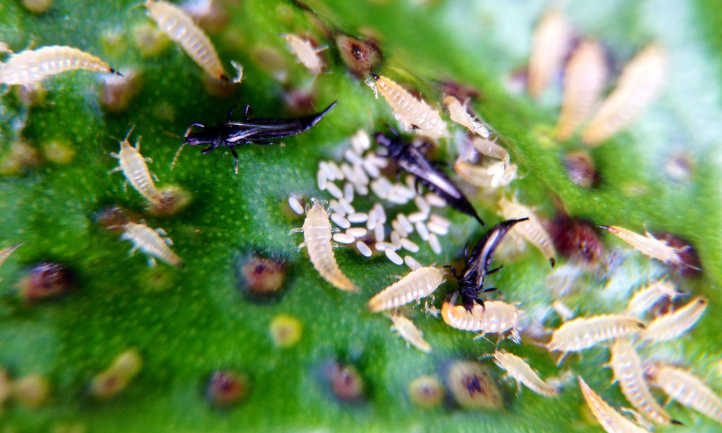
Female thrips lay eggs in host plants, within the surface plant tissues of leaves, flowers, and stems, and under the bark of trees or shrubs. The eggs hatch 1 to 2 days later for indoor species, and outdoor species’ eggs hatch within 1 week. The eggs are shielded from weather conditions in the soft tissues of the plant. Female thrips are capable of producing eggs asexually if they lack a mate.
When they hatch, there’s a food source at hand for young thrips, also called larvae. Many species go through two larval stages as nymphs before becoming adults. A few types have more larval stages, some reaching as many as five. At the end of their nymph stages, thrips populations cease feeding, and fall to pupate in plant debris, or within plant crevices or galls. Greenhouse thrips pupate on the undersides of leaves, whereas Laurel thrips pupate within the leaf tissue. Though this isn’t a true pupal stage, the appearance of thrips changes greatly, and adults emerge with wings.
Some species can enter diapause. Diapause is almost like suspended animation. Thrips can survive like this as adults, pupae, or eggs. The average lifespan for these bugs is about 45 days.
Identifying Thrips Damage
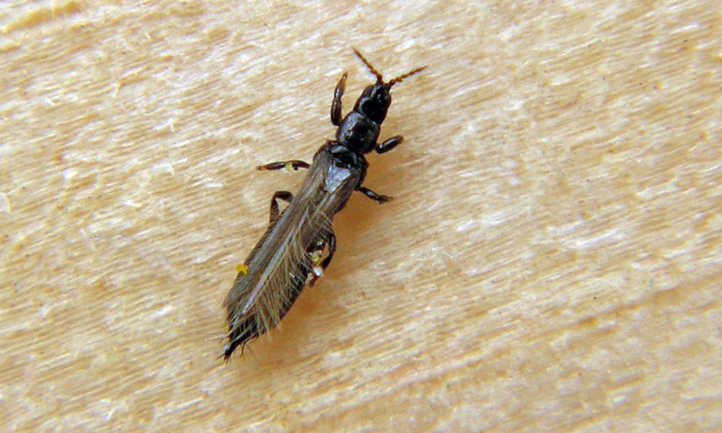
Although thrips damage on trees and shrubs is usually not terminal, they are more of a threat to vegetable crops. They harm fruit, leaves, and shoots, and can change the overall appearance of indoor and outdoor plants alike. Also, they may stunt plant growth and cause papery, curling leaves. Defoliation is also a result of thrips feeding on plant juices. They distort flower buds and leaf tissues. Thrips feeding can also cause discolored, rolled terminals. Petal tissue may be discolored or stunted. Some leaves take on a silvery sheen.
As thrips consume plants, they leave behind dust-like poop. This is always a tell-tale sign thrips are around. Western flower thrips can cause streaking on roses and woody shrub stems. A few species of thrips cause the majority of thrips-related problems in a garden. Western flower thrips are vectors for Impatiens necrotic spot virus and Tomato spotted wilt virus, which can kill plants. In addition, thrips that are viral hosts can damage seedlings as crops emerge.
There are some varieties that are beneficial. These species tend to feast on other pest types, including mites and aphids. They also will eat plant pollen when pests are not available. It’s very difficult to distinguish between the good and bad types of these bugs.
Generally, if you see no damage on your plants, but you do see the thrips themselves, you probably have the good type and do not need to be concerned. But if you’re seeing visible signs of damage, you’ll need to work towards control.
Controlling Thrips
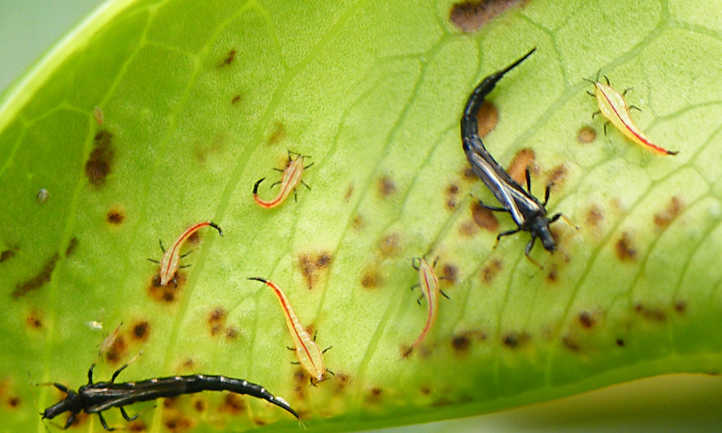
There are many options when it comes to thrips control. Here we’ll discuss how you can manage and get rid of thrips in your garden and prevent the plant diseases they can spread.
Biological Removal Of Thrips
A thrips infestation can be controlled by employing their natural predators. Their natural enemies include predatory mite species, minute pirate bugs, and certain parasitic wasps. These beneficial predators are more present in gardens where dust is minimized, pesticide use is low, and a diversity of plant species exists. It is also possible to purchase thrips’ natural enemies, particularly green lacewing larvae and predatory mites from nurseries or garden-specific vendors.
However, the efficacy of purchase and release methods are in question. Instead, plant cultivars that will attract beneficial insects. Green lacewings and pirate bugs feed on Cuban laurel thrips. Parasitic wasp species feed on greenhouse thrips. Euseius species mites prey upon citrus thrip species. And parasitic nematodes (specifically Thripinema nicklewoodi) control western flower thrips.
Insecticidal Control Of Thrips
Previously, recommendations for organic pesticides included garden favorites neem oil, insecticidal soap, and pyrethrin. While these are effective methods, their efficacy relies on proper application and integration with other strategies. Therefore, apply these insecticides all over plant parts, and ensure there is adequate follow-up. Most of these can be reapplied within 7 to 10 days. Early detection is key as well.
Most thrips can be easily controlled when the first signs of damage show. Do not apply neem to currently blooming plants that rely on other insects for pollination, as this will deter them and prevent fruit production. Spinosad is also a highly effective organic control derived from the bacterium, Saccharopolyspora spinosa. It works much like Bt, in that thrips eat plant matter covered in the bacteria and die as a result. This insecticide works with thrips biology to remove them from the plant in question. Horticultural oil is a highly effective method for use in greenhouses as well. When using all of these products, ensure you’re protecting your skin and eyes. And avoid getting the insecticides on non-affected plants that could take on damage with a too-liberal application.
Insecticides To Avoid
Because they cause a health risk to beneficial pollinators, certain chemical pesticides, systemic insecticides, and organophosphate insecticides are not recommended. They have varying effectiveness depending on what plants and thrips are being treated and controlled. Particularly, acephate is highly toxic to beneficial insects (pollinators and predators) and makes plants more susceptible to spider mites. Carbamates and pyrethroids – as opposed to pyrethrins – are detrimental to beneficial insects, don’t demonstrate efficacy in treating thrips, and increase the likelihood of outbreaks of pest mites. They also drain into waterways, adversely affecting aquatic biology.
Preventing Thrips
To prevent harboring thrips consider integrated pest management strategies that include organic or chemical pesticides and cultural methods of prevention.
Floating row covers placed over crops before they emerge prevent thrips from feeding on seedlings. Inspect the leaves of your plants regularly and prune off thrip-covered plant parts. In conjunction with pruning removal, ensure you remove soil or leaf litter from the garden that may provide shelter where thrips overwinter. If you know you’re growing plants thrips love to eat, grow resistant cultivars that won’t attract them to your garden. Reflective mulch interferes with certain flying insects’ ability to locate certain plants. Use methods for trapping thrips in your monitoring process. Sticky traps help you find out if they’re in the garden at all.
Less effective strategies include the use of diatomaceous earth and kaolin clay. They are most effective when used in conjunction with the other strategies we’ve mentioned so far. However, these methods do deter some pollinators, and should not be applied in the flowering stage. They work to dust plants and cause damage to thrip bodies that cause the pests to dehydrate.
Frequently Asked Questions
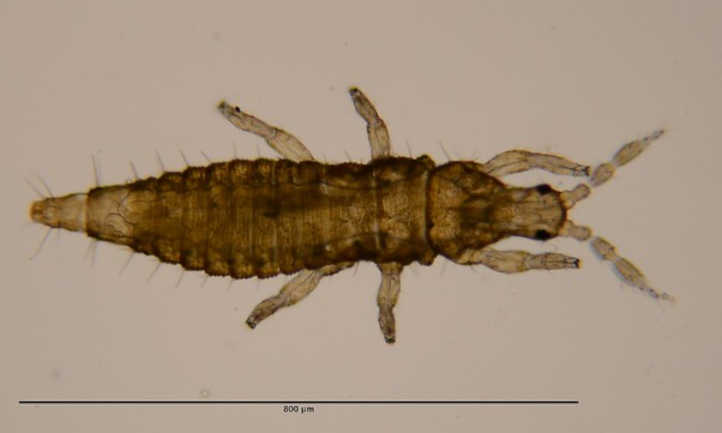
Q: How do you know if you have thrips?
A: What you’ll most likely see first is adult thrips themselves. As you get to know their signs, their excrement may become more obvious to you.
Q: What are thrips attracted to?
A: It depends on the thrip. Overall, they feed on several vegetables, fruit, herbaceous plants, woody shrubs, and trees. Use the guide above to determine which thrips you’re dealing with.
Q: Are thrips hard to get rid of?
A: As long as you are vigilant, and follow an integrated pest management (IPM) regimen that is consistent and persistent, they’re easy to get rid of.
Q: Will nematodes help keep my thrips population down?
A: Yes and no. As thrips often overwinter and pupate in the soil, beneficial nematodes can help wipe out any pupae underground. Since most of the population is made up of adults or nymphs who are above-ground, nematodes should be used in conjunction with other pest control methods.
Q: Do thrips bite?
A: Yes. While thrips aren’t harmful to humans or pets, those who have sensitivities to bug bites might experience some irritation. Usually, washing the bite in warm to hot water with soap will reduce any itching it may cause. It’s more of an annoyance than something to be concerned about.

